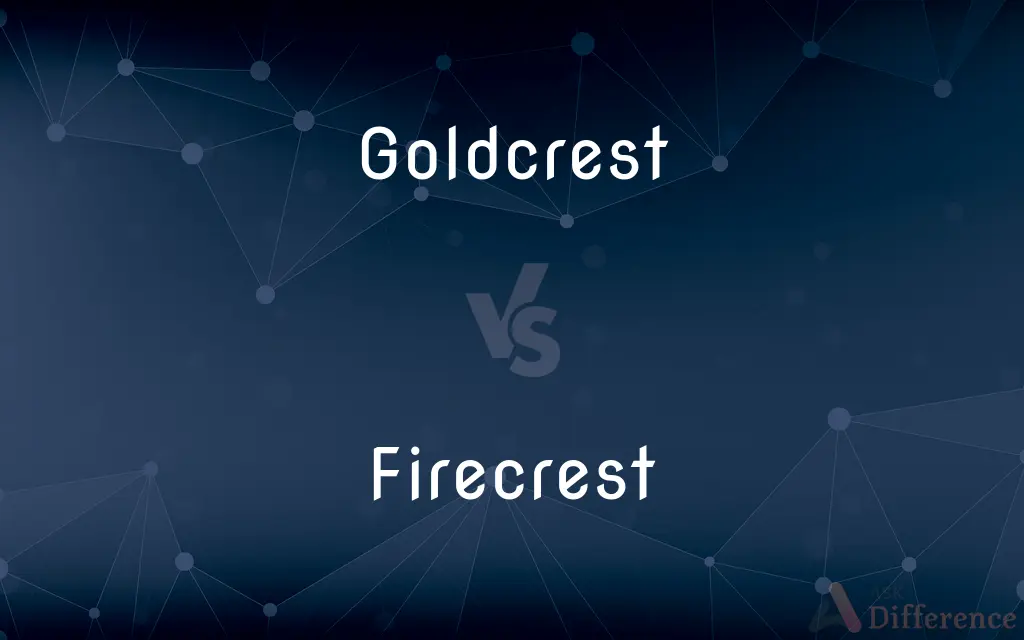Goldcrest vs. Firecrest — What's the Difference?
By Maham Liaqat & Urooj Arif — Updated on March 30, 2024
The Goldcrest is Europe's smallest bird, recognized by its yellow crest, while the Firecrest, slightly larger, boasts a distinctive orange-red crest stripe.

Difference Between Goldcrest and Firecrest
Table of Contents
ADVERTISEMENT
Key Differences
The Goldcrest (Regulus regulus) is often celebrated for its vibrant yellow crest stripe, a key feature distinguishing it from many other small birds. This crest can vary in hue, particularly during mating displays. On the other hand, the Firecrest (Regulus ignicapilla) features a striking orange-red crest stripe, setting it apart not only from the Goldcrest but also making it one of the most visually distinctive small birds in its habitat.
Habitat preferences between the two species show some overlap but also notable differences. Goldcrests prefer coniferous forests, thriving in pine, spruce, and fir trees across Europe and parts of Asia. Whereas, Firecrests are more versatile in habitat selection, found in mixed forests and often venturing into gardens and parks, making them slightly more visible to human observers.
In terms of behavior, both species exhibit similar foraging techniques, actively searching for insects and spiders in tree foliage. However, the Firecrest is known to be more aggressive in defending its territory, especially during the breeding season. This assertiveness extends towards other small birds, including Goldcrests, when resources are scarce.
The vocalizations of these two species are distinctive yet can be challenging for the untrained ear to differentiate. The Goldcrest's song is a high-pitched series of notes that gradually accelerate, while the Firecrest's song contains a more varied pitch and often includes a distinctive trill not found in the Goldcrest's call.
Breeding behaviors show similarities, such as their preference for building suspended nests in trees, but the Firecrest often incorporates more feathers and fluff into its nest structure for insulation, a nod to its slightly broader habitat range which includes cooler regions.
ADVERTISEMENT
Comparison Chart
Crest Color
Yellow
Orange-red
Habitat
Primarily coniferous forests
Mixed forests, gardens, parks
Size
Smallest bird in Europe
Slightly larger than the Goldcrest
Territorial Behavior
Less aggressive
More aggressive, especially in breeding season
Vocalization
High-pitched, accelerating notes
Varied pitch with a distinctive trill
Nest Construction
Uses moss, spider webs, and lichens
Incorporates feathers and fluff for insulation
Compare with Definitions
Goldcrest
Known for its high-pitched song and agility in dense coniferous foliage.
The Goldcrest's song added a lively backdrop to our forest walk.
Firecrest
Exhibits aggressive territorial behavior, especially against intruders.
The Firecrest we observed was boldly chasing away larger birds.
Goldcrest
Prefers dense, coniferous woodlands for both feeding and breeding.
We set up our birdwatching station near a pine forest, hoping to catch a glimpse of a Goldcrest.
Firecrest
Adapts well to various habitats, including urban areas.
Firecrests have become more common in our local park, much to the delight of birdwatchers.
Goldcrest
It builds suspended nests from moss, spider webs, and lichens.
The intricate nest of the Goldcrest was hidden among the fir tree branches.
Firecrest
Nests are heavily insulated with feathers and fluff, suitable for a range of temperatures.
The Firecrest's nest, a cozy haven for its chicks, was meticulously crafted.
Goldcrest
A tiny bird with a distinctive yellow crest, found across Europe and parts of Asia.
The Goldcrest we spotted was flitting energetically from branch to branch.
Firecrest
A small bird with a striking orange-red crest, often found in mixed woodlands.
The Firecrest's vibrant crest made it a standout sight in the garden.
Goldcrest
Despite its small size, it migrates considerable distances.
The endurance of the Goldcrest during migration is remarkable.
Firecrest
Its song contains a distinctive trill, differentiating it from the Goldcrest.
The melodic trill of the Firecrest's song is a true forest treasure.
Goldcrest
The goldcrest (Regulus regulus) is a very small passerine bird in the kinglet family. Its colourful golden crest feathers, as well as being called the "king of the birds" in European folklore, gives rise to its English and scientific names.
Firecrest
A very small passerine bird, Regulus ignicapilla, that breeds in Eurasia.
Goldcrest
A very small passerine bird, Regulus regulus, that breeds in Eurasia.
Firecrest
A small European kinglet (Regulus ignicapillus), having a bright red crest; - called also fire-crested wren.
Goldcrest
The European golden-crested kinglet (Regulus cristatus, or Regulus regulus); - called also golden-crested wren, and golden wren. The name is also sometimes applied to the American golden-crested kinglet. See Kinglet.
Goldcrest
European kinglet with a black-bordered yellow crown patch
Common Curiosities
How can I distinguish between a Goldcrest and a Firecrest?
Look for the crest color: yellow for Goldcrests and orange-red for Firecrests.
Are Goldcrests and Firecrests aggressive birds?
While both species can be territorial, Firecrests are notably more aggressive, especially during the breeding season.
Can Goldcrests and Firecrests live in the same habitat?
Yes, their habitats can overlap, especially in mixed woodlands, but they have different preferences that reduce direct competition.
What do Goldcrests and Firecrests eat?
Both species primarily feed on insects and spiders found in tree foliage.
Where can I find Goldcrests and Firecrests?
Goldcrests are mainly in coniferous forests, while Firecrests prefer mixed forests but can also be found in gardens and parks.
Is there a difference in the nesting habits of Goldcrests and Firecrests?
Yes, while both build suspended nests, Firecrests often use more insulation materials, like feathers and fluff.
Do Goldcrests and Firecrests migrate?
Goldcrests are known to migrate considerable distances, while Firecrests tend to be less migratory, though some movement is observed.
How do I attract Goldcrests and Firecrests to my garden?
Planting native trees and shrubs, especially those that attract insects, can create a welcoming environment for these birds.
Can Goldcrests and Firecrests be found in urban areas?
Firecrests more commonly venture into urban parks and gardens, while Goldcrests usually stick to more wooded areas.
What challenges do Goldcrests and Firecrests face?
Habitat loss, climate change, and predation are significant challenges for both species.
Are Goldcrests and Firecrests easy to spot?
Due to their small size and the dense foliage they prefer, both can be challenging to spot, but Firecrests might be slightly easier due to their habitat variety.
How long do Goldcrests and Firecrests live?
While specific lifespans vary, small birds like these typically live for 2-5 years in the wild, though exceptions exist.
How do the songs of Goldcrests and Firecrests differ?
Goldcrests sing a high-pitched series of accelerating notes, while Firecrests' songs are varied in pitch with a distinctive trill.
Are Goldcrests and Firecrests protected species?
In many regions, efforts are made to protect their habitats, which indirectly helps conserve their populations.
What is the breeding season of Goldcrests and Firecrests?
Their breeding season typically spans from late March to early August, depending on the region.
Share Your Discovery

Previous Comparison
Opposed vs. Opposite
Next Comparison
Fajita vs. TacoAuthor Spotlight
Written by
Maham LiaqatCo-written by
Urooj ArifUrooj is a skilled content writer at Ask Difference, known for her exceptional ability to simplify complex topics into engaging and informative content. With a passion for research and a flair for clear, concise writing, she consistently delivers articles that resonate with our diverse audience.
















































